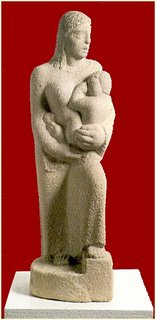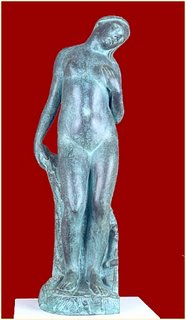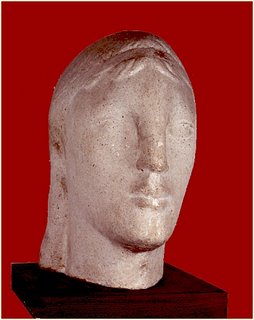The success and failure of Polygnotos Vagis

This is what I would call the success of Polynotos Vagis (1892-1965)-- the Greek who came to New York at 17 --- served in the Navy --- went to art school -- and in 1923 came under the patronage of that great name in American modern art, Gertrude Vanderbilt Whitney. (above piece from 1938)

And this looks like a Rodin portrait (it's of the sculptor's grandfather) and it won him museum-world recognition at the beginning of his career in 1922.

Another nice piece from a year later -- still under the shadow of Rodin.

Bit what a difference a decade makes! Was this piece, from 1932, done by William Zorach ? It's right there in that dreamy social idealism of the New York Sculptors Guild. Very enjoyable -- I admire it -- and this might have been the high point of his career -- with a one-man show at the Brooklyn Museum.

And I enjoy this "Nereid" -- although this is where he begins to turn a corner -- that eventually leads to this:

(above piece is titled "Eagle with rabbit")
and -- gasp -- this:

So what happened ?
Maybe he got sick -- or depressed -- or homesick -- or lonely -- whatever --- I don't know --but I do think he got neglected over the last 25 years of his life. The artworld that had summoned and nurtured his talent -- during what I would call the golden age of American sculpture -- abandoned him -- and eventually he abandoned it -- and his new country -- sending his lifetime of work back to the Greek island of Thasos from which he came -- and on which a small museum currently maintains his legacy.
There were many expatriate Europeans who came to America and seemed to fit right in: Lachaise, Nadelman, Jennewein, Polasek, Maldarelli etc. But I suspect that as a Greek -- he might have felt pretty lonely in the world of high-culture in which he made his living.
(note: my interpretation of his life is almost the complete inverse of an essay published on his Greek musem's website here -- and it should be noted that the two rocks shown in the above image recently sold at auction at Sotheby's.
So maybe today he finally is being honored as a pioneer of "found objects" ?
I guess there's no accounting for taste.
(note: apparently, at one point, he had pieces in the permanent collection of the Met, the MOMA, the Whitney, the Brooklyn, and the Toledo museums of art -- but looking online -- none of them mention him on their sites. But still -- he's the only
Greek sculptor of the past century to have any kind of legacy on the internet.
Yiannoulis Halepa, Thanasis Aparti, Antonios Zohos, and Michalis Tobros are even more neglected than he is.)


7 Comments:
Chris
This is starting to look like a textbook on the last 100 years o sculpture -- i am learning a great deal here; I am sure I am not the only one. This is not just fun, it is also valuable!
Come to think of it -- there's another side of this history as well: the forgeries. The 20th C. artworld is so obsessed with authenticity, a great opportunity is created for skillful forgers -- especially with simple archaic styles.
I think that there's a Greek fellow who told a reporter that he made
this one
I love his work. And I love the way you write about it, very witty! Lonely foreigners, that sounds familliar...
Good to hear from you Iian -- and maybe those little carved stones really are treasures when you hold them in your hand -- but regardless, he certainly did change the scale of his work as he got older.
Yes in the later part of his life, his art changed but, not because he abandoned anything - more that he looked inward and became more contemplative.
Poly and his wife Sylvia were family friends of ours most of my early youth. My Dad a surgeon, had saved his life a few times in the mid to late 1950's.
Vagis was an incredible and powerful man. His art and his friends were everything to him and money absolutely meant little to nothing to him. The reason the works he kept went back to Greece is because, as he told me dozens of times, they belong to Greece. Poly agonized over missing his homeland vs. enjoying the freedoms and friends he had here in the States.
And he remained that way until he died. He had said he'd be at my Bar Mitzvah but fell ill. He died 9 days later.
I wonder if you or many here knew he was a painter as well. He only painted two dozen canvases {or less?} in his last decades. I have one he dedicated to my Dad - his friend Alex.
Poly introspectively was a quite curious and serious thinker. I learned a lot as a kid by his side. Our visits were always an adventure. Whether he came to us or we went to him... but, coolest was when I'd spend hours in his studio or his garage or his basement.
If you saw his tools & his hands, you'd know he was an expressionist who bled to carve beauty. If you sat on a hot summer's day and drank cold tea with him, you could close your eyes {as I did} and your ears and brain would be alive by his expressions of life, the value of life and the struggles enduring life.
I've known many artists of most mediums but, there was only one VAGIS!
Cheers, Jon Messer - Scottsdale, AZ
Jon Messer, I just read your bit about Poly, we called him Vagis. I knew him well, as a child, from 1940 (or earlier) to the late 50's. I knew him as my father's friend, as I believe you got to know him. Question: One of the last times I saw him, he was recuperating in a friend's apartment in Stuyvesant Town or in Cooper Village. Was that your place?
Bill Bouris (digi@mindspring.com)
My daughter recently purchased a vintage watercolor of what appears to be a Greek harbor scene with an ancient fort at the ocean edge and small boats in the harbor.
It is signed at the lower right by P. Vagis. We do not find anything online regarding his paintings. Where can we get info about his other art works, anyone know?
Post a Comment
<< Home